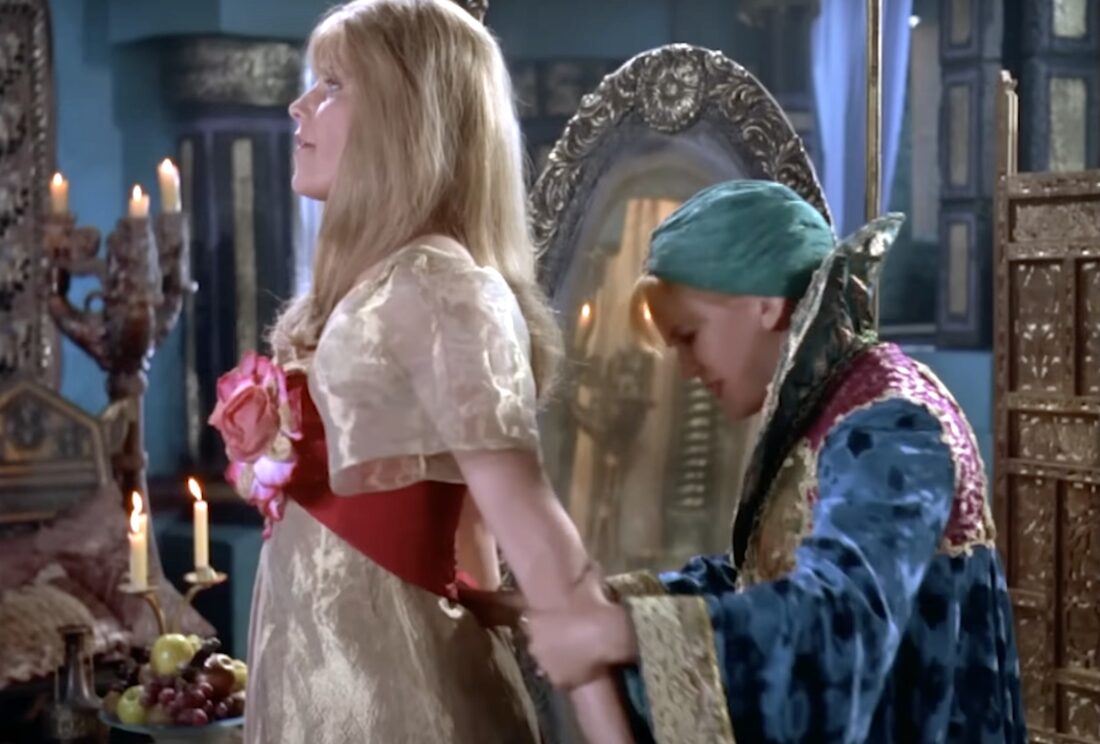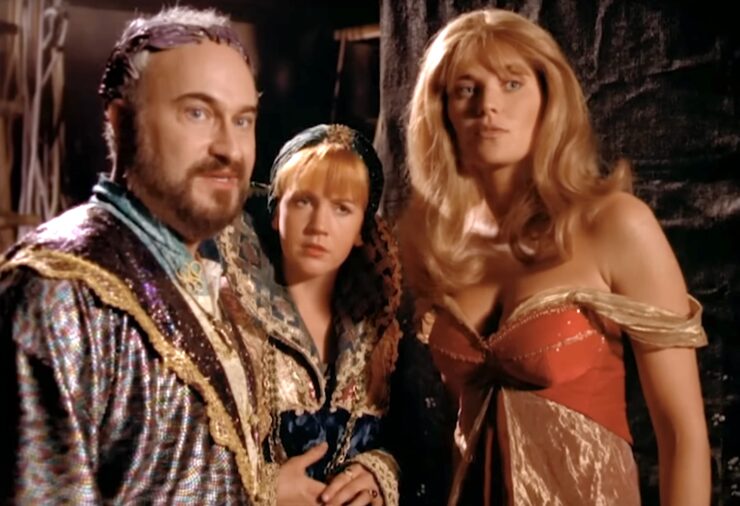No offense to the absolutely fabulous performers death-dropping everywhere from local bars to the world’s largest stages right now, but one drag queen reigned first. All hail Miss Artiphys, the breakout star of a 1997 episode of Xena: Warrior Princess called “Here She Comes… Miss Amphipolis.” A character with wit, warmth, and humor—played by an actual queer person living with AIDS. And for a show where Greek gods regularly drop in from Olympus to mess with characters, maybe the most fantastical aspect of the episode is that there’s no tragic ending for Miss Amphipolis, who actually takes the crown in a beauty pageant. The only killing? When characters slay campy lines.
I’ve been re-watching Xena, now an out adult and not a closeted teen catching episodes with my parents when the show first aired. And by the gods, does this episode have it all. Feminist skewerings of a beauty pageant. Wigs. Musical numbers. Fake accents. All leading up to one extravaganza of a scene when someone accuses Miss Artiphys, wearing Xena’s stolen armor, of being the warrior princess. And Miss Artiphys retorts, “Honey, I’m no princess. I’m a queen!”
In a show that often gleefully slips into comedy as two bisexual warrior partners—their relationship dancing between subtext to chakram-in-the-face text over the course of the show’s seven seasons—travel the world fighting evil, this episode basically takes the crown in the category of camp perfection. And I can’t believe it aired in 1997.
“Stand back, and let her through. She’s the one girl who’ll do,” Salmoneous sings as Miss Artiphys takes her victory stroll down the stage. “A beauty so mythic, her figure’s terrific. She’s Miss Known World.”

The plot of the episode, written by Chris Manheim sure feels familiar to fans of the 2000 Sandra Bullock film Miss Congeniality (guilty as charged), with a thin pretense to get our subversive feminist hero into a beauty contest. Which feels to her so against everything she stands for. Xena (Lucy Lawless, queen in whatever she does especially the existential cylon D’Anna Biers in the re-imagined Battlestar Galactica) and Gabrielle (ray of sunshine Renée O’Connor) receive a message from occasionally shady businessman and friend Salmoneous (recurring guest star Robert Trebor). He’s hosting a beauty pageant and needs their help.
Xena snaps, “You sent urgent word for us to come and see some underdressed, over-developed bimbos in a beauty contest?” And I just love that that barb is coming from someone in a leather breastplate. Gabrielle, too, calls the pageant “a feeble excuse for men to exploit and degrade women.” Wrong, Salmoneous tells them, the pageant is all about keeping peace. A year ago, three area leaders signed a treaty to end years of bloodshed, and the pageant is a way of celebrating the anniversary. The leaders have each sponsored one contestant in the Miss Known World pageant—genius name, by the way—but now someone is messing with things. Destroying costumes, wrecking props, even trying to abduct contestants during practice. The lives of the contestants are in danger as they’re being used to “wage a war by proxy,” Xena observes. The only chance of keeping the peace is for the pageant to go off without a hitch. So what’s a warrior princess to do? Enter the contest herself, naturally, to watch things from the inside, keep the contestants safe, and get to the bottom of the sabotage.
Once Xena and Gabrielle arrive at a palace, the location of the pageant, Xena adopts the airhead persona of Miss Amphipolis, while Gabrielle pretends to be her sponsor, the Marquesa (with O’Connor hamming it up with an overwrought French accent), and investigates how the male leaders are jerks who think the success of the contestants they’ve entered in the competition is all about them. Throughout the day, Xena befriends fellow contestants Miss Messini (Simone Kessell), Miss Parnassus (Jennifer Rucker), and Miss Skiros (Katherine Kennard) and learns why each are in the competition. All for noble means, of course, like winning extra food for their once war-torn village. None of them really want to compete in a beauty contest, never mind risk their lives. Xena saves each of the contestants from various booby-traps on-and-offstage, and faces her own when she’s locked in a steam room and nearly misses the competition.
Surprisingly, it’s not one of the jerk leaders who tries to shove Xena out of the competition, but one of her fellow competitors, the statuesque Miss Artiphys (credited as Karen Dior). Xena confronts Miss Artiphys—the name sure sounds like a Greek village but is pronounced like the word “artifice”—and rips off her blonde wig. Bam! The audience learns that Miss Artiphys wasn’t in fact born a woman.
“Now, I want some straight answers,” Xena demands.
“Have you got the wrong girl,” Miss Artiphys quips.
There’s a lot packed into the tight dialogue that follows. A lot of heart, a lot of nuance. Miss Artiphys admits she was trying to scare Xena out of the competition. She knew Xena figured out her secret and was afraid she’d tell the other contestants. Xena is taken aback, though. What makes Miss Artiphys think Xena would tell? Because Xena doesn’t get it, being born a woman. “This is a chance to use a part of me most people usually laugh at—or worse. The part I usually have to hide,” Miss Artiphys tells her, sinking. Xena says she thinks she understands. All Miss Artiphys asks, now, is that Xena will let her leave the competition privately without telling the others.
No way, Xena immediately says. Then she hands Miss Artiphys back her wig, telling her, “May the best person win.”

The rest of the episode rolls out in a pleasantly predictable way. Xena saves the day and uncovers the saboteur. The male leaders more or less realize their dickishness, and each of the contestants vow to achieve their goals without banking on a beauty pageant. They all resign in turn, leaving Miss Artiphys as the winner—the only one who seemed to love the displays of exaggerated femininity of the pageant, anyway—and she glides down the stage, rapt while wearing her crown. She even plants a kiss on Xena, much to the surprised (or slightly jealous?) look on Gabrielle’s face.
Looking back, it’s wild to realize that this episode aired in 1997, when queer people (most especially trans people) were the source of jokes in the media, political punching bags, and literally getting disowned by their families. Not that we’re at all living in a perfect time for queer people now, since, in America alone, the ACLU is currently tracking over 500 discriminatory laws against the community. But I’m not going to even dive into the million television shows and movies of the time that reduced trans people to villains or sex workers (who usually ended up dead)—the 2020 documentary Disclosure discusses this beautifully. In 1997, fear and misinformation about AIDS was basically still at its height—which only makes the kiss between Lawless and Dior more significant.
It’s hard to say definitively if Miss Artiphys is trans, but she’s clearly queer. A few pieces of evidence steer me in the direction of celebrating Miss Artiphys as a drag queen who identifies as male, though, rather than a transwoman performing drag. Episode writer Chris Manheim stated in a 1999 interview with Xena fandom site Whoosh that Miss Artiphys was inspired by her brother, Keith K. Walsh, who performed in drag, and the episode is dedicated to his memory. Karen Dior is the nom-de-drag for Geoffrey Gann, an adult performer, actor, director, and singer, who identified as male, which you can read about in his saucy memoir Sleeping Under the Stars: Explicit Memoirs of a Decade in Porn (his byline there is Geoffrey Karen Dior). Another reason to see Miss Artiphys as male-identifying is that the episode features a couple of pretty innocuous gay gags, including closing banter about Miss Known World being a man, which would be so completely out of character, contrary to earlier scenes—and worse, really harmful—if Gabrielle and Xena were misgendering Miss Artiphys.
Dior, who passed away due to AIDS-related complications in 2004, isn’t around to ask if he played the character as a drag queen or transwoman. See her however you want though. Because, praise Sappho, she’s still a winner, baby.

Xena still holds a spot on the altar of queer reverence. Lawless herself, after the series ended in 2001, told Lesbian News in a 2003 interview that she viewed the relationship between Xena and Gabrielle as “gay, gay. Definitely.” At various times in the show’s history, the producers and writers seemed to buck back against the idea held by many queer fans that characters were partners, with male lovers for each of them popping in now and again, and puzzling character choices. Or they swung right in the opposite direction and leaned in. I’ve been picking up on gems that went over my head when I watched as a kid, or I was too embarrassed to acknowledge because they would out me. Like one particularly hilarious moment in the season three episode “Been There, Done That,” when one character asks Xena if she has a hickey, and Gabrielle—clearly embarrassed and guilty—looks away.
Re-watching “Here She Comes… Miss Amphipolis”, the scene when Xena first confronts Miss Artiphys still hits with the right heartfelt notes. But after writing about drag for years, what I looked at with new appreciation was the talent portion of the pageant, which sees Miss Artiphys dancing and waving ribbons while circus music plays in the background. Her confidence, her megawatt smile even as she’s wrapped up in ribbons and bouncing off the stage.
It reminded me of talking with popular drag queen Katya Zamolodchikova a few years back, ahead of a book she and pal/frequent collaborator, Trixie Mattel, released, Trixie and Katya’s Guide to Modern Womanhood. Katya explained drag as subversion and satire. How she slips into the role of womanhood as a performance, “in order to illuminate the artifice and its ridiculousness. Like, to simultaneously enjoy this kind of arbitrary set of rules and features while broadly broadcasting their uselessness or their ridiculousness.” Well, would you look at that. Artifice is right there in the name—like Miss Artiphys having the time of her life with her head held up as she struts the hell down the runway with her crown. And lucky for us, we get to see.










